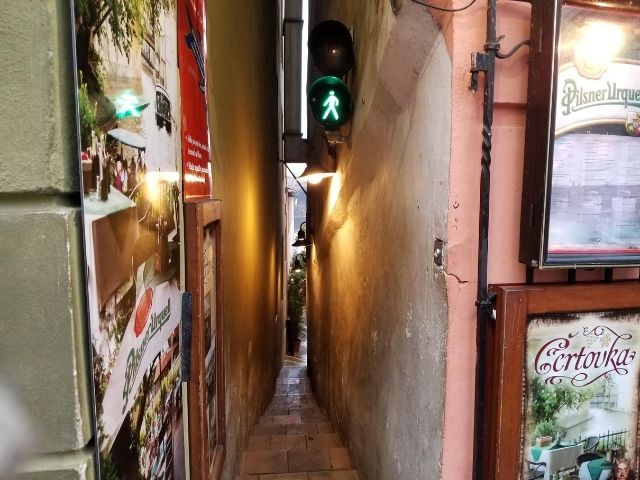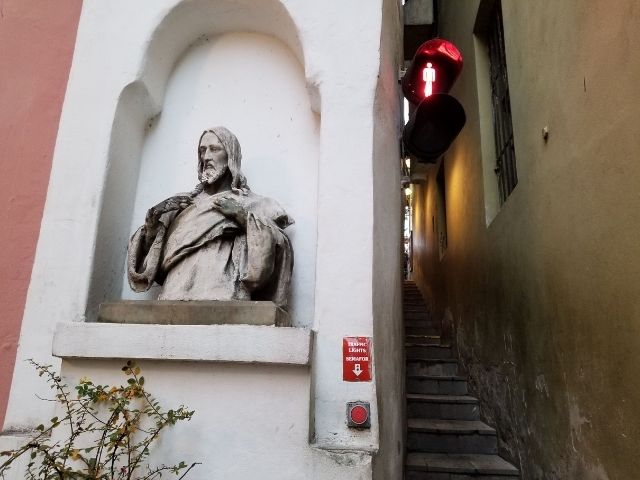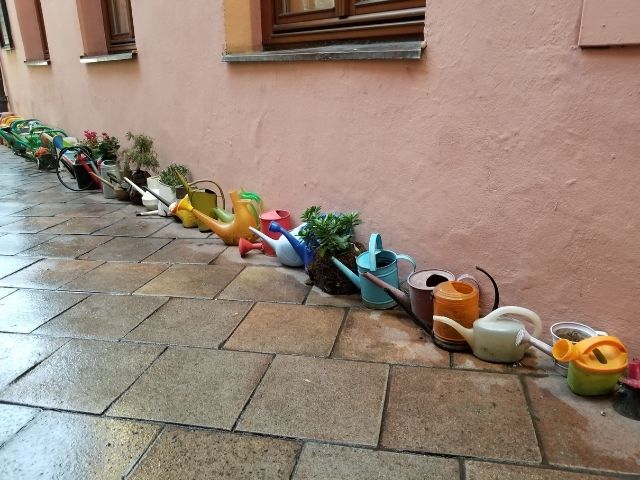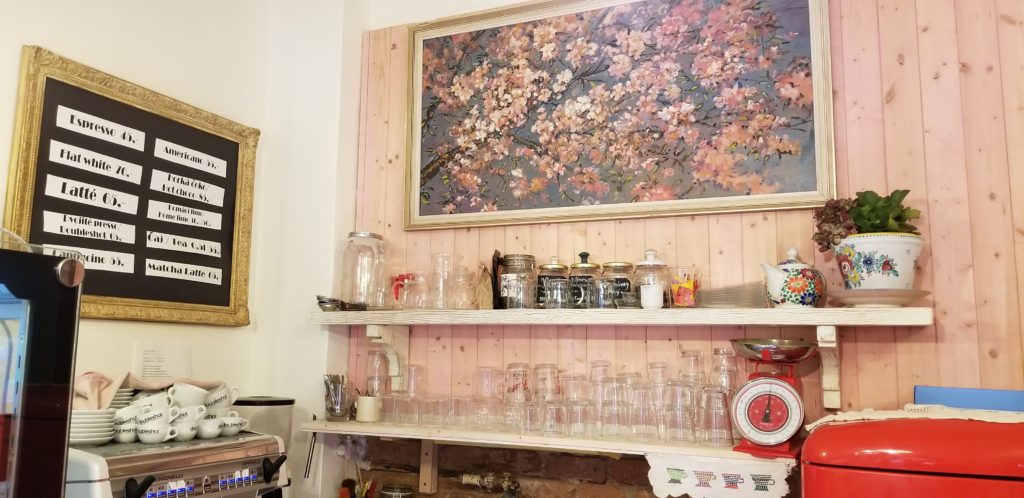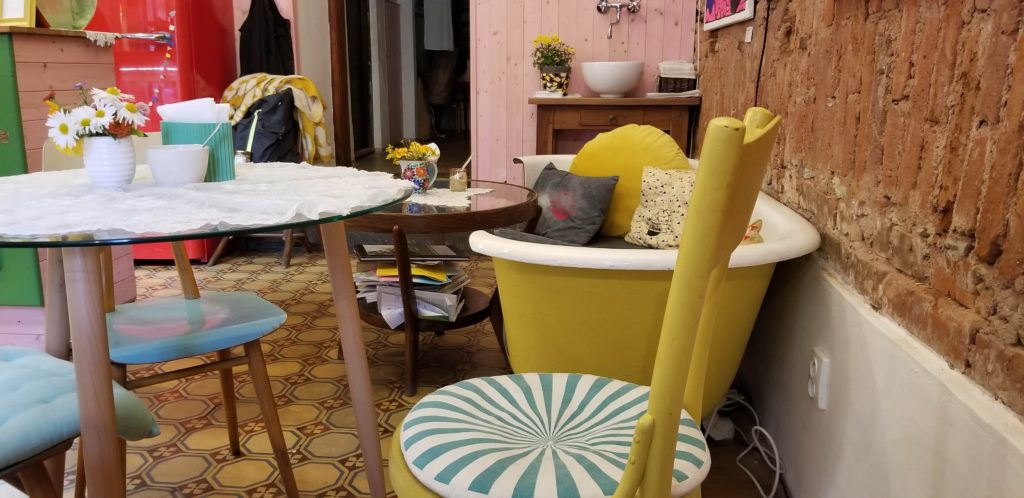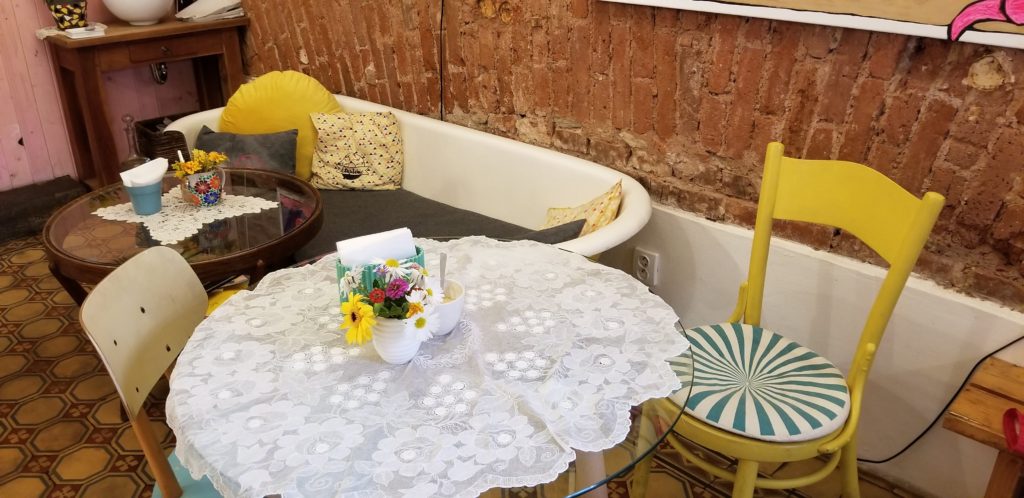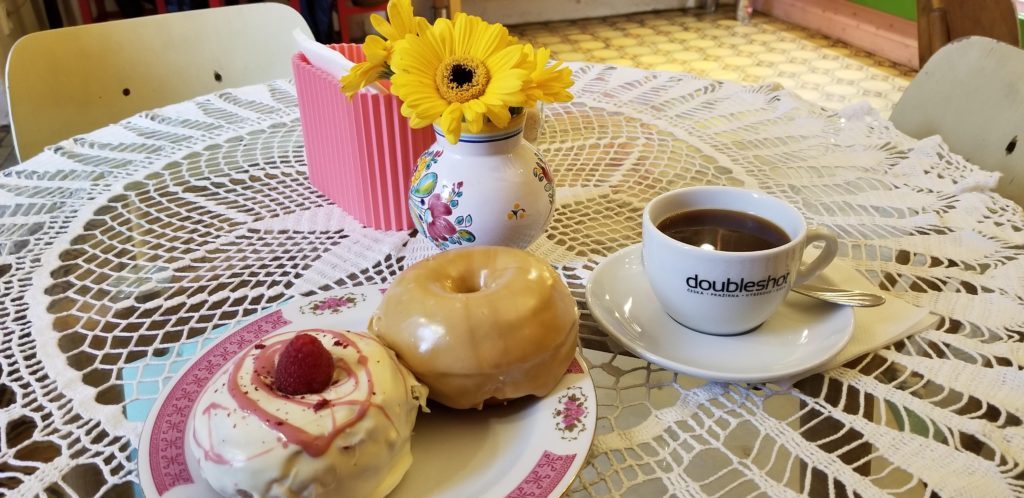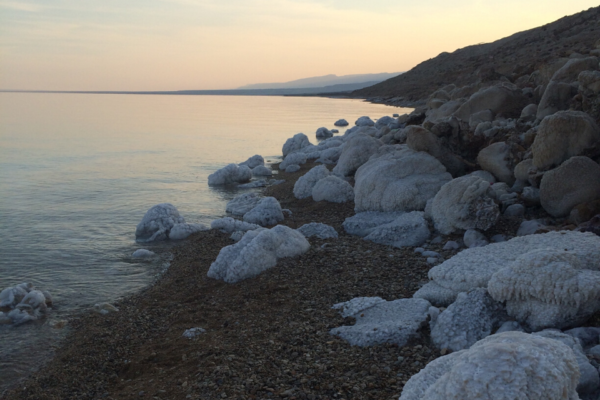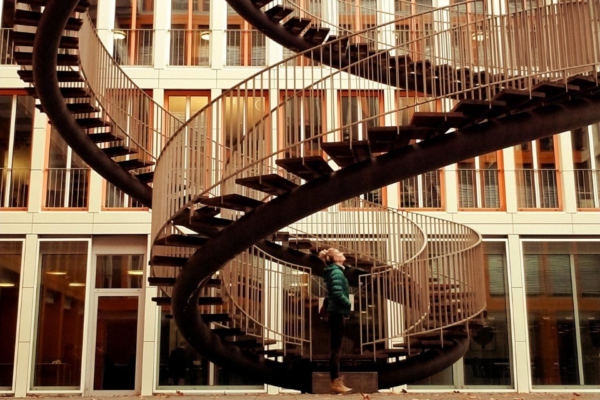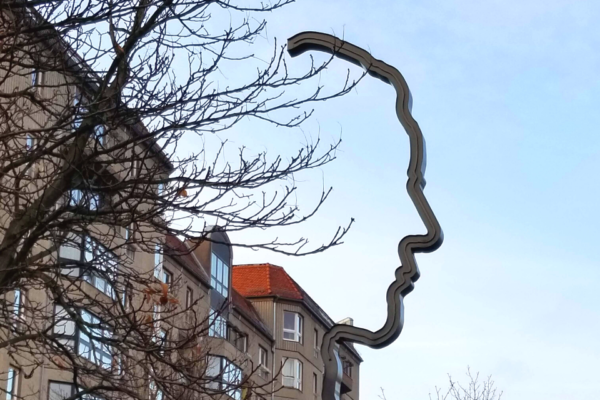Prague is an absolute jewel. The “city of a thousand spires” lives up to its reputation as a dreamy, romantic, grand European capital. There’s plenty of things to see and do on Prague’s well-worn tourist track, but if you’re up for something a little more offbeat, check out my top picks for unique things to see and do in Prague (bonus: most of them are free).
HLAVA FRANZE KAFKY (FRANZ KAFKA’S HEAD)
Location: 5 Charvátova
Ever wanted to see a bizarre sculpture of Franz Kafka’s head? Here’s your chance! This artwork is really cool. It’s made of 42 discs that rotate in different directions at different times. Sometimes they all align, forming Kafka’s normal face, then they move and the face warps and disintegrates, only to reappear again a minute or so later.
Franz Kafka was a German-speaking writer who lived the majority of his life in Prague. He was somewhat of a tortured soul and Czech sculptor David Černý created this artwork to represent Kafka’s inner torment.
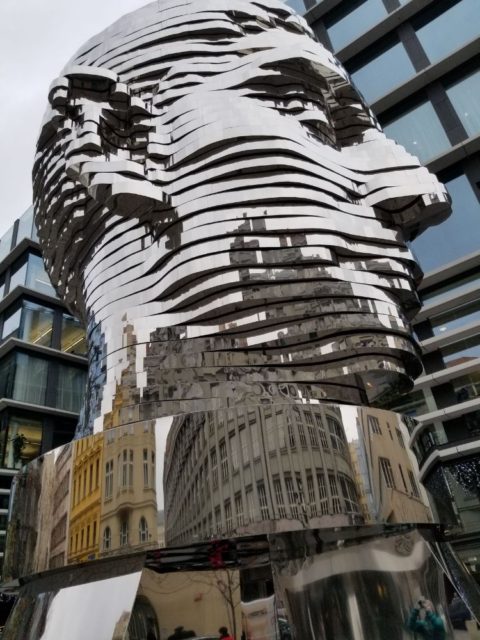
I was surprised at how shiny the sculpture is. If you like photography, it’s worth walking around the sculpture to find the view that includes the best reflection of the surrounding buildings. And it’s hard to avoid your own reflection, so wear something you like!
MAN HANGING OUT
Location: Husova Street at the corner of Řetĕsová
Don’t panic! It isn’t what it looks like! This interesting (and let’s face it: kind of creepy) artwork is a sculpture of Sigmund Freud hanging from a pole that he’s holding with his right hand. From certain angles, his arm looks like a noose, causing alarm to passersby who think they’re witnessing a suicide.
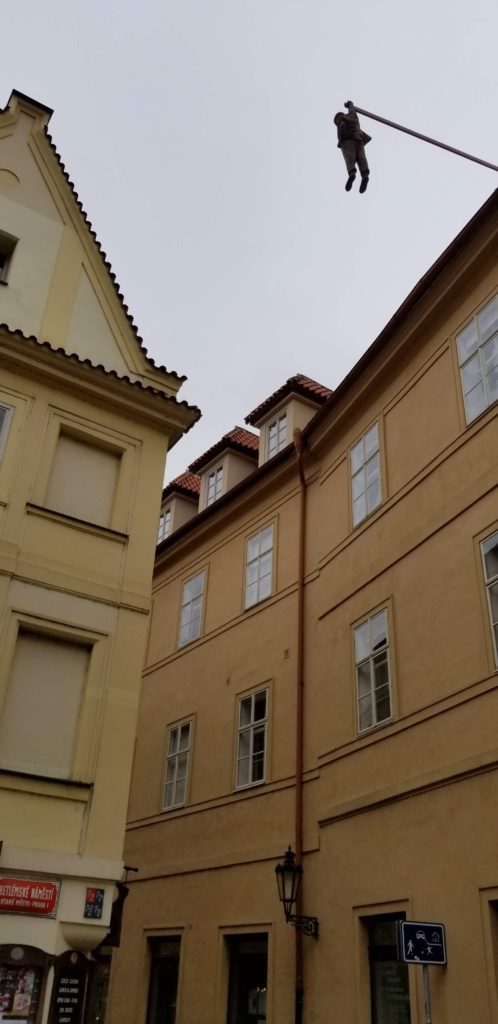
Czech sculptor David Černý created this startling piece. While it has some initial shock value, the meaning behind it is simply a representation of the artist’s uncertainty about intellectualism in 20th-century Prague.
Man Hanging Out is dangling over Husova street at Skorepka, just around the corner from Betlémské Náměstí (Bethlehem Square). I recommend walking around this area because while it is in the Old Town, it’s a little bit off the main tourist track and is a little more peaceful than the nearby streets.
LENNON WALL
Location: 4-6 Velkopřevorské Náměstí
John Lennon was murdered in 1980 and shortly after, someone painted a picture of him on this nondescript wall across from the French embassy. Since then, artists and dreamers have covered the wall in Lennon lyrics and Beatles-inspired art. The Knights of Malta own the wall and a few times tried to whitewash it with the help of the police. But art will not be silenced! It never took long for the wall to be re-covered in colourful, Beatle-y graffiti.
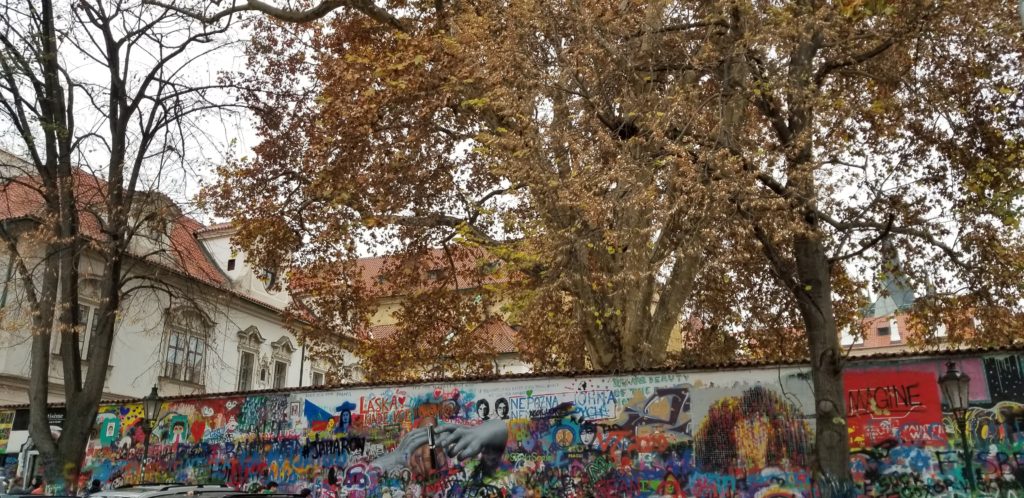
While the wall is located in a calmer, less touristy part of the city, it is certainly a tourist destination. When I went, I couldn’t really approach the wall because there were so many people in front of it. And several smaller groups nearby were huddled around tour guides who were telling them the story of the wall. So, if you want to see it up close, I recommend going early in the morning.
VINÁRNA ČERTOVKA
Location: 24 U Lužického Semináře
Just a short distance from the Lennon Wall, you will find what can only be described as the narrowest street in the world. In fact, it’s a tiny passage between two buildings and it’s such a tight squeeze, a pedestrian traffic light was installed to avoid people getting stuck trying to pass each other!
At the bottom of the passageway is a tiny courtyard with a bizarre collection of watering cans. It’s a strangely peaceful little place. Which is good, because once you’re down there, you’ll probably be stuck for a while waiting for tourists to stop blocking the passage while taking photos. That’s the problem with the traffic light: people can’t see it from inside the passage, so even if you pressed the button, you still have to just wait for people to get out of the way.
MEMORIAL TO THE VICTIMS OF COMMUNISM
Location: Újezd 420
Czech sculptor Olbram Zoubek and architects Jan Kerel and Zdenek Holzel created this sculpture in 2002 as a memorial to the victims of Communism. It’s important to remember that after WWII ended, Czechoslovakia (as it was at the time) was under Communist rule for over 40 years. This was a very difficult time and many people lost their lives.
The seven figures in the sculpture become more disintegrated the further they are from you. It represents how Communism affected political prisoners. The bronze strip on the ground shows estimated numbers of people affected in different ways by Communism, such as exile, arrest, dying in jail, or being shot while trying to escape.
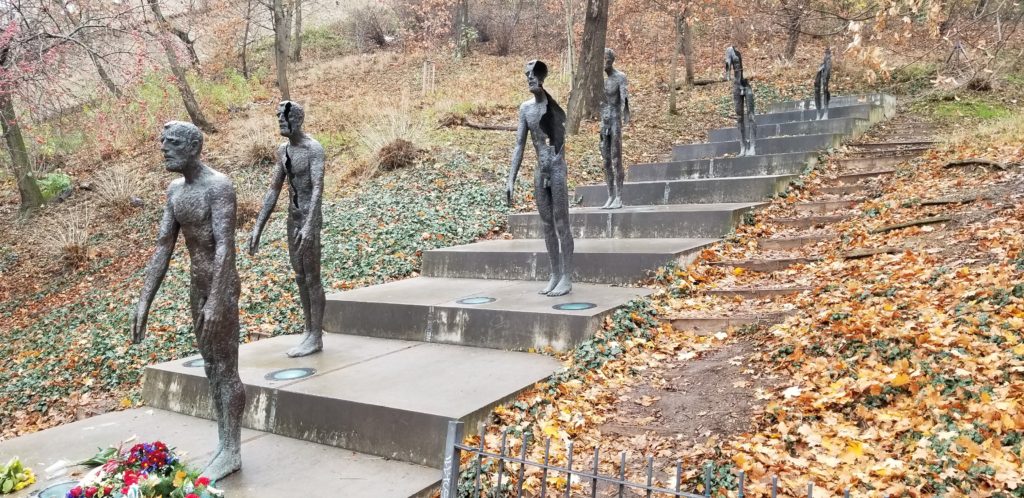
There were and are several controversies about this memorial. That in itself tells you something about how recent and raw the topic of Communism is in Eastern Europe. Despite the controversies, as a traveller, I appreciate the presence of the sculpture, which prompted me to learn more about the history of the Czech Republic. I think that’s the purpose of art: to create awareness and make people think.
JAN PALACH MEMORIAL
Location: 60-62 Václavské nám.
Jan Palach was a Czech student who protested the Soviet occupation of Czechoslovakia with self-immolation in Wenceslas Square. That means he set himself on fire. And the worst part is, he didn’t immediately die. He was transferred to a hospital with severe burns and died there several days later in great pain at the age of 20.
His protest was not just against the Soviet occupation, but the way it had demoralized the Czech people. He felt they were giving up and giving in. Palach was not alone in his concerns. His funeral turned into a large-scale protest against the occupation, and one month later, his friend and fellow student, Jan Zajic, immolated himself in the same place Jan had.
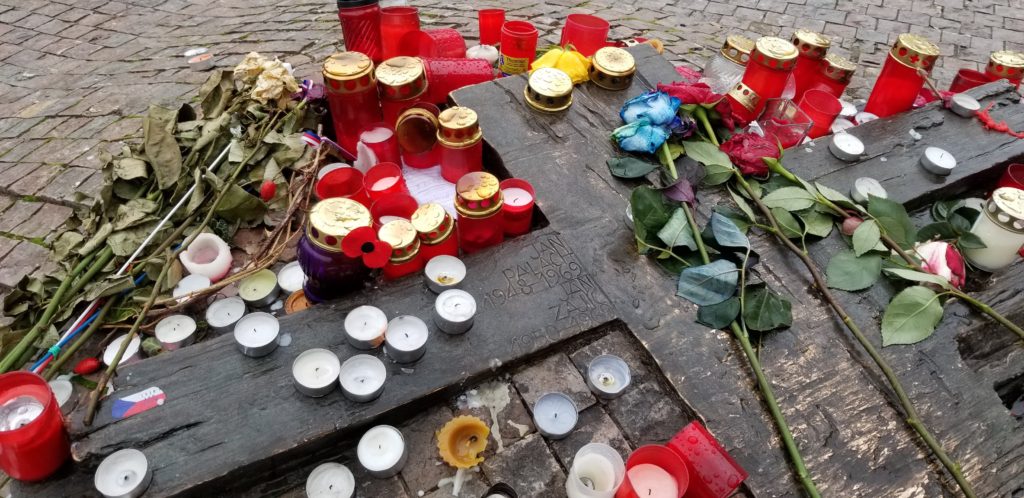
Today, large-scale demonstrations and even acts of self-immolation still occur around the anniversary of Palach’s death. He is memorialized in several places around Prague and the world. This memorial is in front of the National Museum, in the place where he burned himself. I was there in November and even though it was just a regular day, people were still placing candles to memorialize him.
MEMENTO MORI
Location: Nuselský most
Prague’s Nusle Bridge has an unfortunate nickname: Suicide Bridge. It’s probably not difficult to guess that this nickname comes from the remarkably high number of suicides from this bridge since its completion in 1973.
Underneath the bridge you will find a simple art installation by Czech artist Krištof Kintera. It’s a lone streetlight, twisted at the top so the light shines upward onto the bridge. It has a plaque on it that reads “In memory of all those who took their life in this place.”
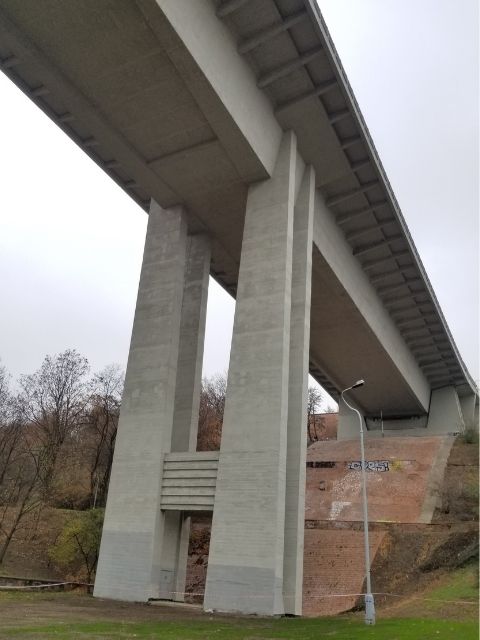
Suicides in public places typically go unpublicized so as not to put ideas into people’s heads. In this piece of art, Kintera has literally shone light on an issue that impacts many people but few talk about. I wondered how it would look to a person standing on the bridge, to look down and see a light shining up at them.
The full name of the installation is Memento Mori: Of One’s Own Volition. The bridge now has a tall chain link fence along the sidewalks, topped with a 3-foot-wide strip of polished metal, making it impossible to climb. The lamp does illuminate at night time, and if you want to see it, I recommend going with a friend as the location feels a little dicey.
IDIOM INSTALLATION
Location: 1 Mariánské nám.
In the foyer of Prague’s Municipal Library, you will find a never-ending tunnel of books! Actually, it’s an art installation called “Idiom”, created by Slovak artist Matej Kren, who lives and works in Prague. It’s a tunnel of books with an opening in the front. When you stick your head in the opening, mirrors at the top and bottom create an optical illusion that you are in an endless tunnel of books. It’s a bit of a trip because your brain knows you are in a small room, yet the tunnel seems to go right through the floor and the ceiling!
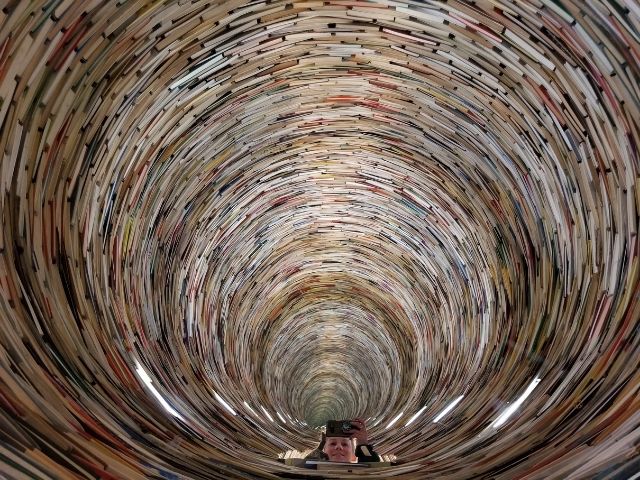
I also enjoyed examining the outside of the tunnel, reading the titles on the book spines. The books were actually donated from the Prague Municipal Library, so most of them are in Czech. But you can’t pull them out – this isn’t Jenga!
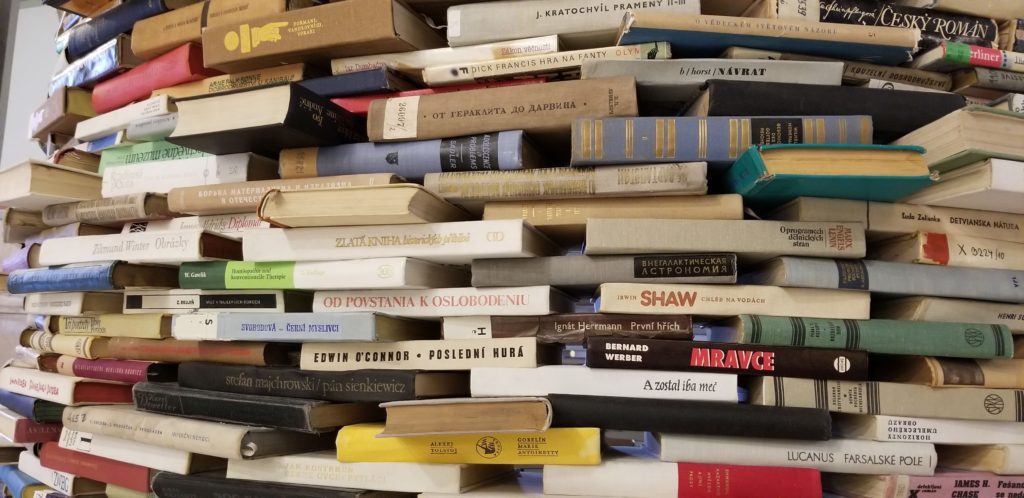
HEYDRICH TERROR MEMORIAL
Location: Resslova 9a
Reinhard Heydrich was a very, very high-ranking Nazi official, in charge of designing and executing the Final Solution (to rid Europe of all Jews). His nickname was “The Butcher” and Hitler himself called Heydrich “the man with an iron heart”. Says a lot about him.
In 1942, two Czech paratroopers tried to assassinate Heydrich in Prague. As Heydrich’s open-top car slowed around a corner, one of them stepped in front of the car and fired his pistol at Heydrich. But the gun jammed! Heydrich stood up and tried to shoot him, but the other paratrooper threw a grenade into the car. The blast did not immediately kill Heydrich but infection from his wounds killed him a week later.
The paratroopers ran and hid in the Church of Saints Cyril and Methodius. For three weeks, Nazis took brutal and horrific revenge on Czech people, murdering thousands, until someone betrayed the paratroopers’ hiding place.
Nazi soldiers first tried to gas them, then broke in with machine guns, killing several people including one of the paratroopers. The other paratrooper and three other Czech fighters were hiding in the crypt and the Nazis couldn’t get in. So they lined up firetrucks outside and blasted water into the crypt through a crack in the wall.
This memorial is where that crack was. You can also see bullet holes and shrapnel scars on the walls. The people in the crypt did not die from the flooding. They killed themselves instead.
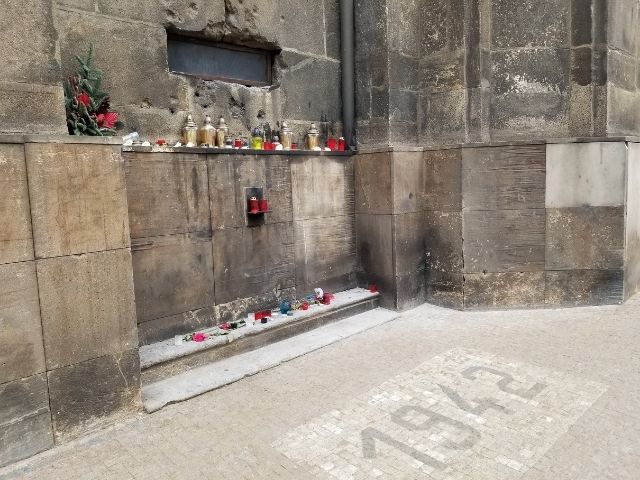
This whole story is portrayed in a film called Heydrich, which I happened to watch on Netflix while on the bus from Munich to Prague. It’s a difficult movie to watch, with lots of violence, but I was glad to know the story of this memorial before seeing it. I admire the bravery of the paratroopers and other resistance fighters and I appreciate their sacrifices.
OLD JEWISH CEMETERY IN ŽIŽKOV
Location: 3 U Starého hřbitova
Žižkov is one of the up-and-coming neighbourhoods in Prague. Before WWII, it was considered a rough area, and since then it has been gentrified, becoming a pretty hip place to live. Several hundred years ago, cemeteries were not allowed within city limits for public health reasons, which is why this historic cemetery lies outside of Prague’s Old Town.
The oldest gravestone in this cemetery belongs to rabbi and poet Avignor Kara, who died in 1439. His elegy describes a pogrom of the Prague Ghetto in 1389 and is still recited in Prague’s main synagogue on Yom Kippur. The most recent gravestone is from 1787, after which a new cemetery was established further away.
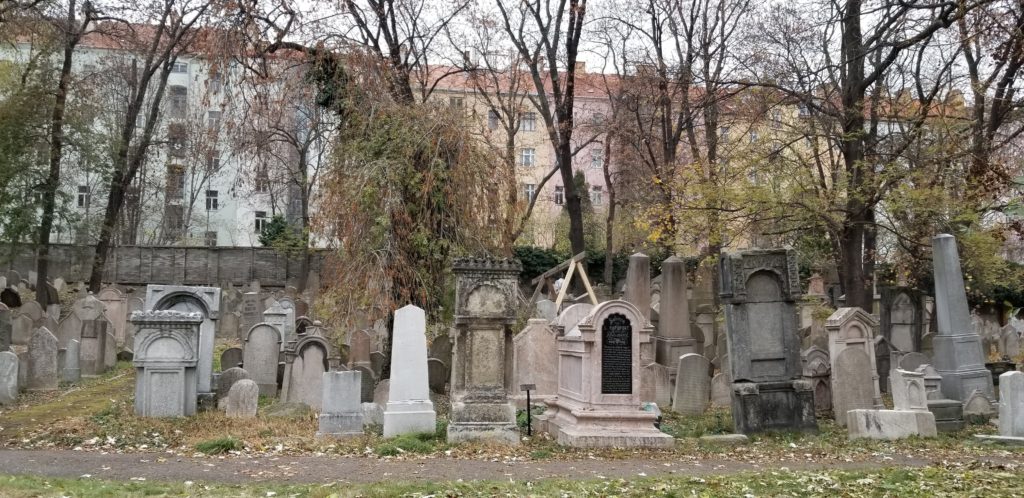
The Old Jewish Cemetery is very crowded. Jewish custom does not allow removal of old graves so newer burials were layered on top of old ones. In fact, sand was even shipped in a few times to raise the ground level and allow for more burials. In some places, the bodies are 12 deep. This is why the gravestones appear all jumbled up.
As you walk around the cemetery, you may notice small stones stacked on top of the gravestones. This is a Jewish custom, to show respect for the dead. The cemetery has chestnut trees, so I also saw chestnuts placed on top of the gravestones along with the pebbles.
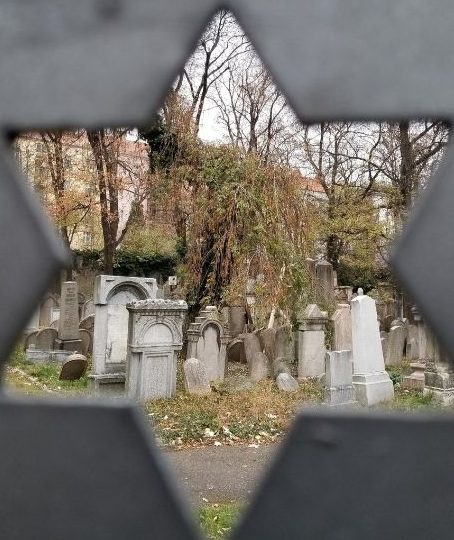
There are several signs inside the cemetery indicating no photography or filming, so I took these photos through the fence from outside the cemetery.
TANČÍCÍ DŮM (DANCING HOUSE)
Location: Jiráskovo nám. 1981/6
This trippy building was designed by architects Frank Ghery (Canadian-American) and Vlado Milunic (Croatian-Czech). The lot that it’s built on used to have a house on it but that was destroyed by US bombing in 1945. The lot stayed undeveloped until the ‘90s, when this building was started.
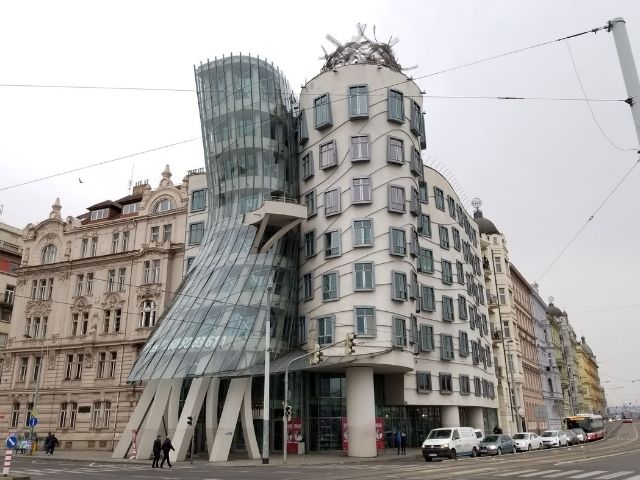
The last president of Czechoslovakia, Vaclav Havel, lived next to the site and was a strong supporter of this building. He wanted it to be a cultural centre. During construction, which took four years, Czechoslovakia split and Havel became the first president of the Czech Republic. The Dancing House was completed but instead of a cultural centre, it’s offices.
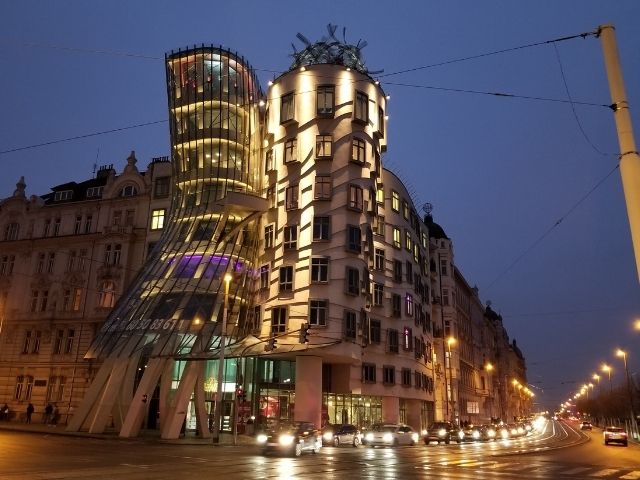
If you want to take a nice photo of it, I recommend standing on the little concrete island in the middle of the intersection and waiting until one of the vintage trams flies by to snap your shot. It’s also fun to see this building both in the daytime and at night, when it’s all lit up.
DOG BAR
Location: Národní 339/11
I have no photos of this because once you are there, you will be having way too much fun to take any photos. Dog Bar is a subterranean labyrinth of nooks and crannies. There’s swings, mezzanines, cozy nooks, and a foosball “hall”. It’s one of those places where you can smoke indoors and there’s no wifi. Good music, cheap beer, and an awesome chill vibe – it’s the kind of place you just lose track of time.
DONUTERIE
Location: Náprstkova 215/9
End your trip on a sweet note with the best donuts you have ever had in your life. A friend recommended Donuterie to me and I didn’t really get what could be so special about donuts. But as soon as I got there, I knew these were no ordinary donuts. Donuterie donuts are out of this world.
The donuts are handmade and decorated right in the shop. I struggled to pick just one so obviously got two, and even then I wanted to try them all! Raspberry white chocolate and salted caramel were divine. They also have vegan donuts, coffee, and boatloads of ambience. It’s a cozy little shop that you will love to spend time in, whether alone or with your (donut) lover.
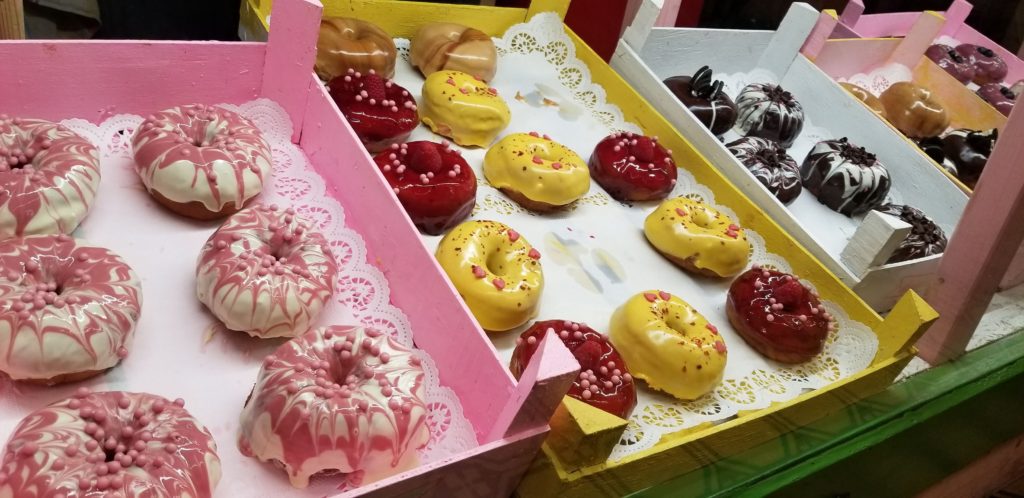
So, there you have my picks for the best unique things to see and do in Prague. I have to give a shout out to one of my favourite websites (and books), Atlas Obscura, for directing me to many of these places. Everyone I talked to about Prague before I went there had such good things to say about it and now I see what they mean. I can’t wait for my next quirky, offbeat, delicious visit to Prague. See you there?

